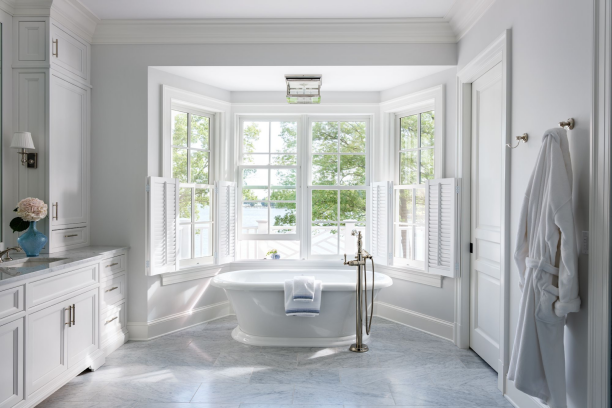
Finding the ideal bathtub size can be a difficult challenge when there are so many different sizes available. The typical bathroom is already so cramped that trying to comfortably fit everything in might feel like fitting pieces into a jigsaw puzzle. The bathtub has changed from being only a practical object to a focal point of bathroom design as a result of the rise in home decor trends and the focus on luxurious bathing experiences. This article will go deeply into the world of bathtubs, assisting you in choosing the right one for your needs and available space while also understanding the many different bathtub sizes and styles.
Different components of the bathtub
A typical drop-in style bathtub takes up more than 13 square feet of floor space and is a common fixture in many homes. Despite the fact that every bathtub is distinct, normal tubs have exterior dimensions that are roughly 60 inches long, 30 inches broad, and 14 to 16 inches high. These measurements are essential for the layout of your bathroom and the overall design. The material of a bathtub is also a component; alternatives range from fiberglass to cast iron, each of which offers a different bathing experience.
The Importance of Bathroom Layout
Space Management
The space in bathroom facilities is usually insufficient, especially in metropolitan settings. It follows that thorough planning of your region is necessary. Every inch counts,The location of the bathtub, its closeness to other fixtures, and ensuring mobility all depend on careful space design. Even in very small bathrooms, it’s imperative to leave at least 12 inches between the edge of the tub and any fixtures. As a consequence, the user feels more comfortable while still maintaining functionality.
Tips for Smart Positioning
When positioning the standalone tub, elegance and function must be combined. In smaller bathrooms with constrained space, it’s critical to ensure that the freestanding tub doesn’t impede mobility. The standalone tub’s edge should be kept at least 12 inches away from other fixtures. By having an open floor area that is at least 24 inches wide around the freestanding tub, the bathroom might appear bigger and less crowded. Never forget that striking a balance between design and utility is crucial.
Different Types of Bathtubs and Their Sizes
Alcove Bathtubs

Many homeowners select alcove bathtubs, which are identified by their location within a space limited by three walls. They are frequently the best choice for tiny or typical-sized bathrooms. These baths are normally between 30 and 36 inches broad and 5 to 6 feet long. The front panel of the design—often referred to as an apron—is typically finished, and the surrounding walls are intended to cover the remaining three sides. When thinking about an alcove bathtub, it’s critical to precisely measure the available space to make sure the tub will fit properly while yet allowing enough room for mobility. An alcove bathtub is set against the far side, so the two long walls form the ends and back of the bathroom.
Drop-in Bathtubs

Drop-in bathtubs have a luxurious appearance and are made to fit into a built-in deck with tile or similar material covering the top and exposed sides. In larger bathrooms, the tub deck can fit into a room corner and be left exposed on two sides. Drop-in bathtubs don’t have factory-finished sides like alcove bathtubs do. Instead, they are made to slide into a deck cutout, much like a drop-in sink slides into a vanity countertop. Depending on the size of your bathroom and your preferred design, these large bathrooms can be placed in a variety of locations. However, because the built-in deck can occupy a sizable amount of area, they work best in larger settings.
Oval Bathtubs

Oval baths are considered to be elegant and luxurious. They are available in freestanding or drop-in variants. Despite appearing to be large, they are often only wider than normal bathtubs, not longer. If you’re thinking about getting an oval bathtub, it’s important to consider the extra width, especially if you choose a drop-in model. This entails building a bigger apron for the tub to rest on, which may change how your bathroom is organized in general.
Whirlpool Bathtubs

Whirlpool baths are the epitome of spa-like indulgence. Many of these are available in typical alcove-ready sizes, but they may look bigger than standard tubs. Jetted whirlpool mechanisms can be installed without increasing the footprint. The jets in these corner tubs provide a massage-like effect, making them perfect for anyone looking for a peaceful bathing experience. When considering installing a whirlpool bathtub, it’s critical to consider the additional plumbing requirements and check that the bathroom has adequate space for the tub.
Corner Bathtubs

Corner bathtubs are all about luxury and relaxation. They are great for folks who prefer reading in the tub or watching television on the wall. Because they are often square in shape with one corner chopped off, these bathtubs are a good choice for large bathrooms with plenty of space. They can be configured in many ways, such as a triangle shell or a drop-in tub attached to a triangular deck.
Freestanding Bathtubs

Bathtubs that stand alone and are not confined by walls or installed in alcoves are known as freestanding fixtures. They can be purchased in many different designs, such as modern pedestal tubs and traditional classic models. They offer positional flexibility and could act as the centerpiece of a bathroom’s decor. Freestanding bathtubs may be a fantastic alternative for people with mobility concerns or areas with plenty of senior citizens. However, they do require more space all around—typically an extra 3 inches on each end and 4 inches on each side. Even though they provide for creative flexibility, they are therefore best suited for larger bathrooms or those with a layout that can handle a tub of this size.
Related Post: 10 Best Freestanding Tubs for 2023
Do you feel dazzled by too many styles? That’s okay, I’ve prepared a form for you to choose the bathtub that’s best for you based on your situation.
| Type | Features | Advantages | Disadvantages | Best Used For | Typical Size (LxW) | Recommendation Index (1-5) |
| Alcove | •Bounded by three walls •Finished front panel | •Space-efficient •Common choice •Versatile | •Limited design flexibility | Small or standard-sized bathrooms | 5-6 feet x 30-36 inches | ✩✩✩✩ |
| Drop-in | •Fits into a deck •Exposed top and sides | •Luxury feel •Design flexibility | •Requires larger space •Deck construction needed | Spacious bathrooms with custom designs | Varies | ✩✩✩ |
| Oval | •Wider design •Drop-in or freestanding | •Luxurious •Elegant design | •Requires more width •Not necessarily longer | Bathrooms aiming for a luxury aesthetic | Wider than standard | ✩✩✩✩ |
| Whirlpool | •Jetted mechanisms •Often alcove-ready | •Therapeutic •Spa-like experience | •Additional plumbing •May require more space | Those seeking therapeutic bathing | Often standard sizes | ✩✩✩✩ |
| Corner | •Square with one corner off •Spacious | •Luxurious •Ideal for lounging | •Requires ample space •Specific positioning | Primary bathrooms with ample space | Varies | ✩✩✩ |
| Freestanding | •Standalone, •No need for walls or alcoves | •Design flexibility •Centerpiece potential | •Requires more surrounding space | Larger bathrooms or open layouts | Varies + extra space | ✩✩✩✩ |
Regulatory Guidelines on Bathtub Spacing
Code for International Buildings
It’s not just about aesthetics or personal preferences when planning the arrangement of your bathroom; it’s also about following the International Building Code (IBC). This code is more than simply a list of rules; it’s a well-thought-out framework meant to assure safety and functionality. The IBC frequently specifies the basic minimum distance between bathtubs, emphasizing the significance of user safety and comfort.
For example, the IBC may specify the exact inches of space necessary between the tub’s edge and other fixtures or walls. While these standards may appear to be strict, they are there for a purpose. By collaborating with them, you ensure not just a complaint but also a user-friendly and comfortable bathroom. Following these recommendations, in my experience, can save a lot of money.
Local Regulations
While international standards such as the IBC give a wide foundation, local building rules add an additional degree of complication. These regulations can be fairly varied, reflecting the distinct demands and considerations of many locations. They may go into topics ranging from plumbing complexities to the kind of bathtub materials considered suitable. These municipal rules might feel restricting at times, especially if you have a certain goal in mind.
However, keep in mind that they frequently result from the collective expertise of local specialists who understand the region’s particular issues and demands. Before starting a bathroom remodeling or installation project, especially if you want anything extravagant like a whirlpool or a custom-made bathtub, it’s a good idea (and often illuminating) to speak with local authorities or experienced builders. They can offer insights that blend regulatory knowledge with practical experience, ensuring your bathroom is both compliant and captivating.
The Future of Bathtub Sizes
Bathtub forms and types vary according to home. We should expect greater innovation in bathtub features and sizes as spa-like experiences and the tiny house movement grow more popular. Individuals looking to improve their bathing experience may find exciting alternatives in the future, ranging from eco-friendly materials to bathtubs with built-in digital capabilities. Whether you have a large or small bathroom, the market is likely to offer a bathtub that meets your needs.
Conclusion
Choosing the ideal bathtub is a highly emotional adventure, not merely a practical one. It’s about integrating a work of art into one’s life rather than just fitting a tub into a room. The key factor in your choosing is what resonates with you, even though your bathroom’s size, the design of your bathtub, and even the confusing local construction rules all play a part. There are a variety of options, each telling a unique tale, ranging from the snug alcove baths to the grandiose freestanding ones. I would advise someone who believes in the power of personal spaces to thoroughly research the many bathing possibilities while also listening to their emotions. Because your bathtub won’t simply be another feature in your house; it’ll become a beloved haven once you achieve that ideal balance between practicality and heartfelt design.



